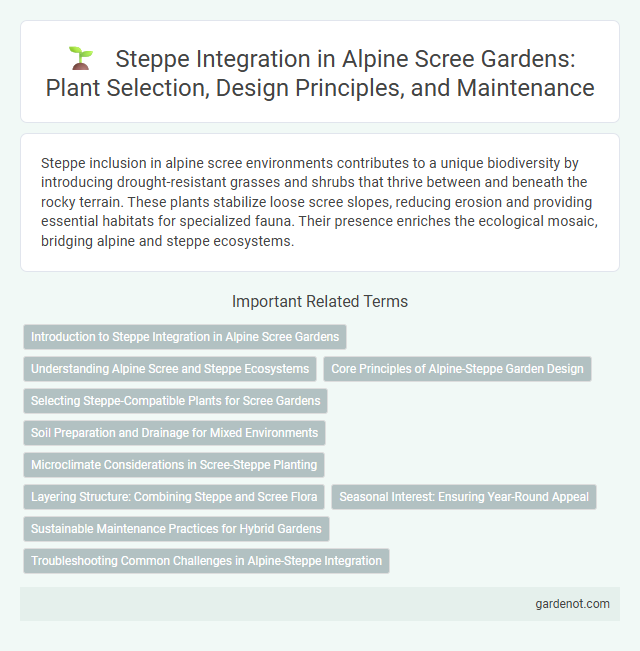Steppe inclusion in alpine scree environments contributes to a unique biodiversity by introducing drought-resistant grasses and shrubs that thrive between and beneath the rocky terrain. These plants stabilize loose scree slopes, reducing erosion and providing essential habitats for specialized fauna. Their presence enriches the ecological mosaic, bridging alpine and steppe ecosystems.
Introduction to Steppe Integration in Alpine Scree Gardens
Steppe integration in Alpine scree gardens enhances biodiversity by introducing drought-tolerant and heat-resistant plant species native to Eurasian grasslands. These plants, such as Stipa and Festuca grasses, adapt well to rocky, nutrient-poor substrates typical of scree environments, improving soil stability and microhabitat variety. Incorporating steppe flora fosters ecological balance and aesthetic contrast, enriching the alpine garden's resilience and visual appeal.
Understanding Alpine Scree and Steppe Ecosystems
Alpine scree habitats feature loose rock debris slopes that provide unique microhabitats supporting specialized flora and fauna adapted to harsh conditions. Steppe ecosystems, characterized by grassland plains with sparse tree cover, contribute to biodiversity by offering transitional zones where steppe species can colonize alpine scree areas. Understanding the ecological interaction between alpine scree and steppe ecosystems reveals critical patterns of species distribution and adaptation in mountainous regions.
Core Principles of Alpine-Steppe Garden Design
Alpine-steppe garden design centers on replicating the unique ecological balance of high-altitude scree environments, emphasizing drought-resistant plant selections such as saxifrages and cushion-forming sedums. The core principles prioritize soil drainage and microclimate simulation to mimic the harsh alpine steppe conditions, promoting biodiversity and resilience. Strategic plant placement enhances natural patterns of growth and survival, ensuring long-term sustainability and aesthetic authenticity in alpine garden landscapes.
Selecting Steppe-Compatible Plants for Scree Gardens
Steppe-compatible plants thrive in scree gardens by adapting to dry, rocky conditions with minimal soil. Selecting species such as Stipa, Artemisia, and Achillea ensures resilience against drought and temperature fluctuations typical of steppe environments. These plants contribute to erosion control and add texture, supporting biodiversity within alpine scree landscapes.
Soil Preparation and Drainage for Mixed Environments
Steppe inclusion in alpine scree environments demands meticulous soil preparation to replicate nutrient-poor, well-drained conditions characteristic of both habitats. Soil composition should emphasize gravelly and sandy textures to enhance permeability and prevent waterlogging, promoting optimal root aeration. Effective drainage solutions, including graded slopes and subsurface gravel layers, are essential to maintain low moisture levels conducive to steppe and alpine plant species coexistence.
Microclimate Considerations in Scree-Steppe Planting
Steppe inclusion in alpine scree planting enhances biodiversity by incorporating drought-resistant species adapted to xeric conditions and fluctuating temperatures. The unique microclimate of scree slopes--characterized by rapid drainage, intense solar radiation, and temperature variability--demands precise selection of steppe plants with high tolerance to water scarcity and thermal stress. Implementing steppe species in scree habitats optimizes soil stabilization and promotes resilient ecological networks within alpine environments.
Layering Structure: Combining Steppe and Scree Flora
Steppe inclusion within alpine scree habitats creates a unique layering structure where drought-resistant steppe flora intertwine with cold-adapted scree species, enhancing biodiversity and ecological resilience. The stratification allows steppe grasses and shrubs to occupy more stable soil pockets while scree plants colonize loose, rocky substrates, resulting in a spatial mosaic that supports varied microclimates. This combination optimizes resource use like moisture retention and sunlight exposure, fostering a dynamic ecosystem adapted to extreme alpine conditions.
Seasonal Interest: Ensuring Year-Round Appeal
Steppe plants included in alpine scree gardens provide vibrant seasonal interest with their drought-resistant foliage and delicate blooms adapted to harsh conditions. These hardy species maintain structural appeal through varied textures and colors that change from spring through autumn, ensuring visual diversity throughout the year. Incorporating steppe vegetation enhances the scree's resilience and supports a dynamic landscape, attracting pollinators and reflecting natural alpine ecosystems.
Sustainable Maintenance Practices for Hybrid Gardens
Steppe inclusion in alpine scree gardens enhances biodiversity by integrating drought-tolerant grasses and shrubs that mimic natural ecosystems, promoting resilience to harsh climatic conditions. Sustainable maintenance practices for these hybrid gardens involve minimal irrigation, organic mulching to preserve soil moisture, and selective pruning to support native species adaptation. Employing these strategies reduces resource consumption while maintaining ecological balance and aesthetic value.
Troubleshooting Common Challenges in Alpine-Steppe Integration
Alpine scree often faces challenges integrating steppe species due to differences in soil composition, moisture retention, and temperature fluctuations. Troubleshooting these issues requires monitoring soil pH levels, ensuring adequate drainage, and selecting steppe plants adapted to harsher alpine conditions. Implementing adaptive management techniques such as controlled irrigation and soil amendments enhances the survival rate of steppe inclusions within alpine scree ecosystems.
Steppe inclusion Infographic

 gardenot.com
gardenot.com